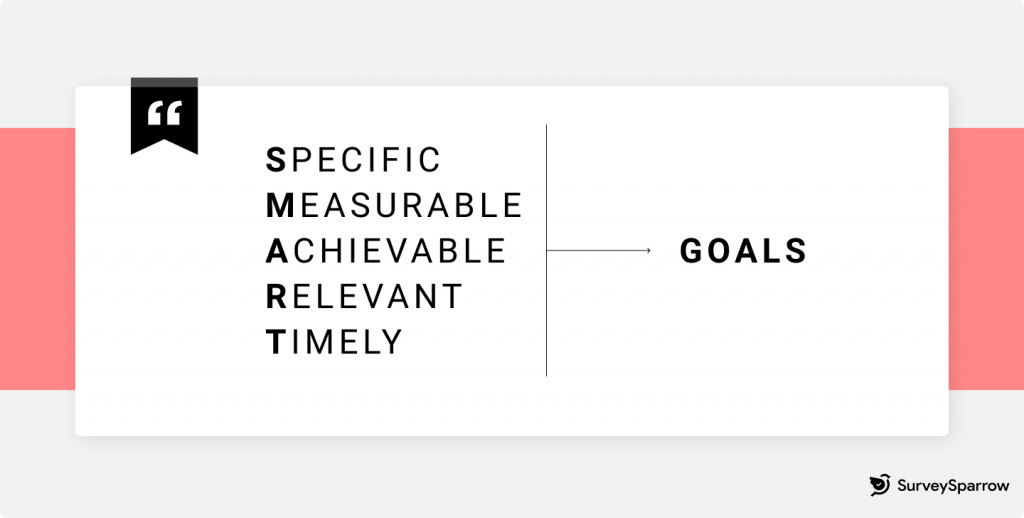Best Of
How To Set SMART Goals for Business (with Template)
Article written by Kate William
Content Marketer at SurveySparrow
10 min read
11 June 2024

Do you often set goals that you never seem to reach (we’re looking at you, New Year resolutions)? Or have you set team-wide goals in the past, only for things to gradually fall off-track? Then knowing how to set SMART goals is just the thing you need.
In this article, we’re going to explain what SMART goals are, how to plan as per SMART objectives, and give you a fun template to help with goal setting.
What are SMART goals?
The SMART goals acronym stands for:

In other words, SMART goals are goals that are achievable within a certain time frame. When writing SMART goals, you must frame them according to 5 components which we will talk about below.
How can the SMART method help you?
Meet Eric. He’s the product marketing manager of his company, tasked with increasing signups for their platform.
He knows he’ll need everybody to pitch in if they are going to meet the target. So he decides to use SMART goals. This will help him:
- Set a plan of action with realistic goals
- Eliminate guesstimates
- Set a clear timeline for the team
- Go all the way to the finish line without getting distracted or losing track
- Maintain stability and accountability in all circumstances
- Track progress
- Identify missed milestones
- Plan the next course of action
SMART goals template
Here’s an example of an online form you can use to build your SMART goal structure.
Want to create more survey templates like this? Get started with a free account!
A personalized walkthrough by our experts. No strings attached!
How to write SMART goals (with examples)
Specific
In order to focus your efforts, you need a specific area of improvement. When there is specificity in the goal, you know exactly where you are headed.
Avoid vague phrasing, and don’t be afraid to go down to the nuts-and-bolts level. Here are the 6 ‘W’ questions that can help you narrow down the ‘Specific’ part of SMART.
- What is it that I want to accomplish?
- Why is this goal important to me?
- Who are the stakeholders involved in this?
- Where is this goal going to be achieved?
- Which resources will I use here?
- When do I want to achieve this goal?
Examples
Here’s an example of a SMART goal that Eric might come up with:
| We want to increase signups for NOPlatform. This will be done by optimizing our web landing pages, CX chatbot, and creating targeted search ads. |
Here’s another example:
| I want to raise my team’s productivity. I will use employee feedback tools to find their pain points and improve the work environment. |
As you can see, these goals cover 4 specifics: what they want to accomplish, the stakeholders involved, where they are going to achieve the target and the resources at play. What’s missing is the ‘Why’, the ‘When’, and the ‘How much?’. That takes us to..
Measurable
The above examples are missing something important. You guessed it: numbers. The Measurable part of a SMART goal means that the goal should be quantifiable. If the goal is large, it helps to break it down into smaller, quantified goals.
When your goal is measurable, it’s easy to track how far you have come. Psychologically, it also gives an enormous sense of satisfaction when you reach or exceed your target number. A measurable goal should be able to address these questions:
- How many/much?
- How do I know when I have reached my goal?
- What are the indicators based on which I will know if I have reached my goals?
Examples:
Let’s take the previous example. Eric and his team want to increase the number of signups for their platform. But how much? Even one sign-up is growth, so how much do they need for meaningful growth? Also, their target audience uses more than one search engine, so where do they advertise? Eric adds some numbers.
| We want to increase signups for NOPlatform by 500 users/month. This will be done by optimizing our top 5 web landing pages, CX chatbot, and creating paid search ads for 3 search engines: Google, Bing, and Baidu. |
Taking the second example:
| I want to raise my staff’s productivity by 80%. I will use employee feedback tools to find their pain points and improve the work environment. |
With numbers, these goals now have a fixed target to aim at. What’s more, it provides an easy way to measure the improvement required in case you fall short of your target.
Achievable
With the right ammunition, you can shoot for the stars. In other words, your goal should only be as lofty as your current resources. An achievable goal tests your skills but at the same time accounts for the human limits at play.
To set an achievable goal, assess the timeframe, skills, and resources currently at your disposal. Ask yourself the following questions:
- How do I accomplish this goal?
- Is my goal achievable?
- Do I have enough resources to make it happen?
Examples:
Eric realizes that the current target will stretch his small team to their limits. What’s more, search ads are expensive, and one of the search engines doesn’t yield enough traffic to justify the cost. So he narrows it down.
| Increase signups for NOPlatform by 200 users/month. This will be done by optimizing our top 5 web landing pages, CX chatbot, and creating paid search ads for 2 search engines: Google and Baidu. |
Taking the second example:
| I want to raise my staff’s productivity by 50%. I will use employee feedback tools to find their pain points and improve the work environment step-by-step. |
With numbers, these goals now have a fixed target to aim at. What’s more, it provides an easy way to measure the improvement required in case you fall short of your target.
Relevant
Relevant (or realistic) goals have a collective, broader benefit to their objective. In other words, they need to matter to you and everyone else who is a part of your plan – whether they are your workout buddies, your team, or your organization.
The ‘R’ part of SMART goals ensures that the goal matters to you, and it also aligns with your other goals. Here are a few questions on relevance that you need to ask while setting SMART goals:
- Is this goal worthwhile for me?
- Am I in the right place to achieve this?
- Does this goal align well with my other goals?
- Am I the right person to pursue this goal?
- Does this goal apply to the current scenario?
Examples
Eric doesn’t want to increase sign-ups through the landing pages and chatbot just because it could work. Instead, he chose these channels because they are major touch points for customer interactions.
| Increase signups for NOPlatform by 200 users/month. This will be done by optimizing our top 5 landing pages, CX chatbot, and creating targeted ads for 2 search engines: Google and Baidu. 90% of our customer interactions come through our chatbot and landing pages. Driving signups through these channels will convert more into paying customers, and thus increase revenue. |
For the second example:
| I want to raise my staff’s productivity by 50%. I will use a comprehensive employee feedback tool like SurveySparrow to find their pain points and improve the work environment step-by-step. By asking for their feedback, the goal is to build a work culture that people want to be a part of. |
See how these examples align with a broader goal? If a SMART goal doesn’t match your overall business or personal objective, consider modifying it or putting it aside.
Timely
Remember when you had to study for an exam? Sometimes you had to push yourself all night in order to finish those essays and projects. That’s why SMART goals include a timely deadline. It helps you prioritize tasks and creates a sense of urgency.
A time frame can also help you see how much you have accomplished within a set period. Here are a few questions on timeliness that you need to ask while setting SMART goals:
- When do I accomplish this task?
- Where do I see myself halfway down the line?
- What should be the kind of progress that I display?
- Which daily tasks do I need to do to make sure I achieve my goal on time?
- What are the deadlines for different milestones?
Examples
When should Eric stop and revise his targets? How often should the team optimize its channels? How many search ads should they create, and when? So Eric completes his SMART goal with a few deadlines.
| Increase signups for NOPlatform by 200 users per month till March. This will be done by optimizing our top 5 web landing pages, and CX chatbot every month. We will create 2 monthly paid search ads for 2 search engines each: Google and Baidu. 90% of our customer interactions come through our chatbot and landing pages. Driving signups through these channels will convert more into paying customers, and thus increase revenue. |
In the second example:
| I want to raise my staff’s productivity by 50% in 6 months. I will use a comprehensive employee feedback tool like SurveySparrow each week to find their pain points and improve the work environment month-on-month. By asking for their feedback, the goal is to build a work culture that people want to be a part of. |
Have a purpose, set some goals, and people will jump on your bandwagon.#quote #quotesmith55 #pupose #goals #MondayMotivation pic.twitter.com/Glieof5BJy
— Ranal Currie (@Ranal55) July 26, 2021
Wrapping Up
Awesome! You have already taken your first step by learning the SMART method. Now you need to keep the momentum going. Like a rolling stone, all your team needs is an encouraging nudge here and there.
- Write it down – on the whiteboard, post-it note, Slack, wherever.
- Have daily or weekly check-ins.
- Track everything – tasks, reports, data, milestones achieved, etc.
- Celebrate every small milestone.
- Periodically reward positive actions.
We can’t wait to see what you will accomplish!
What is your take on SMART goals? What do you think can be improved? Let us know in the comments!
Start 14 Days free trial

Kate William
Related Articles

Knowledge
Everything You Need to Know about Google Forms Header Image Size
6 MINUTES
27 August 2024

Knowledge
Secondary Research: Definition, Methods, Examples
10 MINUTES
17 October 2023

Best Of
Cross-Tabulation in Data Analysis : A Simplified Guide
12 MINUTES
29 June 2022

Best Of
Top Principles You Should Use to Manage Customer Data Effectively
13 MINUTES
25 December 2020
